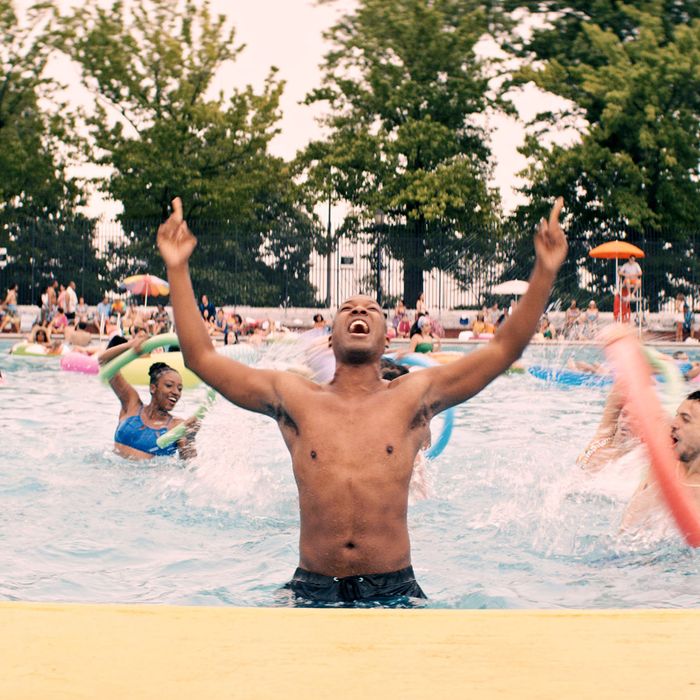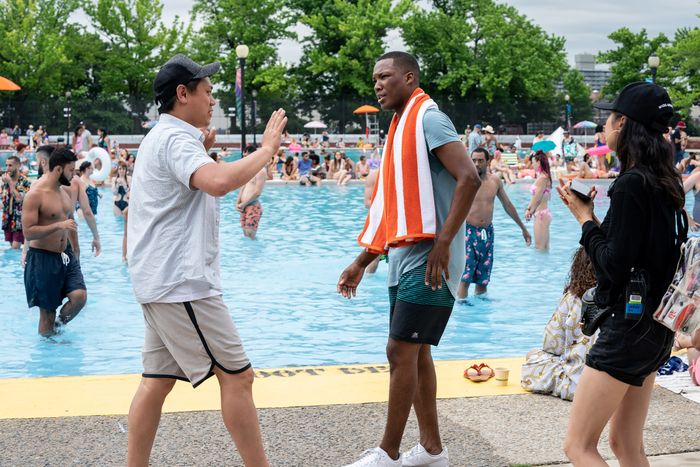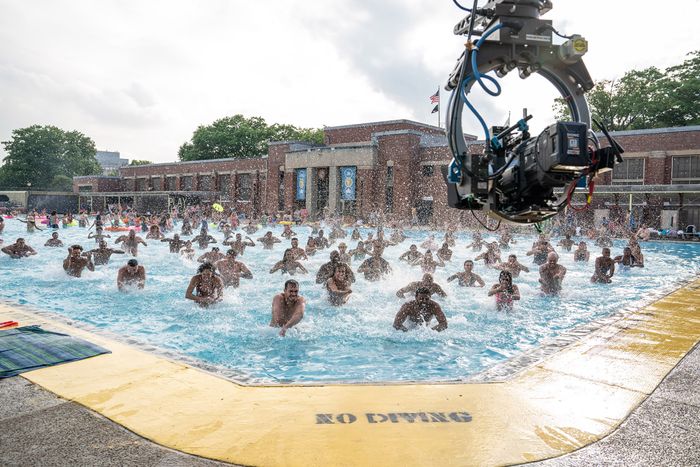
This article was featured in One Great Story, New York’s reading recommendation newsletter. Sign up here to get it nightly.
It’s the hottest day of the year, and four young men are strolling down the block in Washington Heights, bullshitting about their dreams. A winning lottery ticket has been sold at the bodega run by one of them, Usnavi (Anthony Ramos), and the $96,000 prize is the kind of money that could change your life if used wisely. “Yo, if I won the lotto, tomorrow …” Usnavi’s friend Benny (Corey Hawkins) starts riffing.
“96 G’s ain’t enough to retire,” Usnavi points out.
“C’mon, I’ll have enough to knock your ass off its axis!” Benny responds.
“You’ll have a knapsack full of jack after taxes,” Usnavi counters.
It’s early on in director Jon M. Chu’s sweeping film adaptation of In the Heights, the Broadway musical by Lin-Manuel Miranda and Quiara Alegría Hudes. And in this version, they wind up somewhere they couldn’t go onstage: at the public pool, where word about the winning ticket starts to spread like spray from a cannonball. The music shifts into a dancehall beat as different characters take their own verses to rap or sing about what they’d do with that kind of money. The main characters’ melodies layer over each other in counterpoint, the rest of the poolgoers joining in. In the water, swimmers break into choreographed routines. The camera chases a dancer doing a flip into the pool and ducks below the water. The song builds to a crescendo, with the ensemble leaping out of the water together in one of the biggest climaxes of the film.
Each of the songs in In the Heights takes off along its own visual gambit. There’s a dream ballet trip from Cuba to America in the 1940s for the song “Paciencia Y Fe” and a Fred-and-Ginger moment in “When the Sun Goes Down.” The “96,000” sequence, shot on location over three unseasonably cold days at New York’s public Highbridge Pool, is the moment when the movie most adopts the visual grammar of a classic Hollywood musical. Think of the geometric patterns in 1952’s Busby Berkeley–Esther Williams movie Million Dollar Mermaid, with its identical synchronized swimmers, but with modern choreography and a mostly Black and Latinx cast of dancers and actors of varying ages and body types. “This is an ‘I Want’ song not for one character; this is an ‘I Want’ song for the whole neighborhood,” Chu says. “This is a big spectacle, but in the end, this is about yearning. What would these people dream about?”
With In the Heights out in theaters and on HBO Max today, the creative team behind the movie broke down how they made that show-stopping sequence — from how it was first performed on-stage through the grueling shoot and post-production process.
Playing the Numbers
As with many elements of In the Heights, the lottery-ticket plotline came from Miranda’s own experiences while growing up close by, in Inwood. “My earliest memory, full stop, is going with my abuela to the bodega on Dyckman Street and eating candy as she played the numbers,” Miranda says.
The show started out as a rough collection of songs and scenes he wrote and performed as an undergrad at Wesleyan in 2000. In 2004, Hudes — a Puerto Rican playwright who had been working on a play about her own childhood neighborhood in North Philly — joined Miranda to write the show’s book, and in 2008 it premiered on Broadway. The movie version updates the action for a time when DACA exists and the block has already started to change in significant ways. “We had countless four-hour meetings to talk about what era this was in,” Chu says. “We knew we didn’t want to make a movie about gentrification, because in a way, we’re in a post-gentrification time. It’s happening — what do you do now?” That gave “96,000” a new context too: Those who haven’t been priced out of Washington Heights yet are in some ways already lottery winners, says Hudes, who returned to write the film’s screenplay. Still, they know their position is tenuous.
“The plot point is that if you win the lottery, what are you going to do with the money?” Hudes says. “But what that really becomes is everyone in the community fighting over their little vision of what their dream would be. It’s an opportunity, through fantasy play and banter, to touch on what people want out of their life.” Usnavi dreams about sorting out his affairs and heading off to the Dominican Republic, while Benny, ever practical, would want to use his winnings to pay for business school. Most of the women who work at a local salon dream of blowing it on Atlantic City leases and weaves — except Usnavi’s crush, Vanessa (Melissa Barrera), who wants to escape downtown. Sonny (Gregory Diaz IV), the youngest and most idealistic character, dreams of getting the barrio computers and web browsing. “He’s the only one who’s like, ‘If I win, that’s not for me — that’s for my block,’” Hudes says.
Miranda says he chose the number “96,000” for very specific reasons. “It was always intended to be not enough money to permanently change someone’s life, but enough to give them a little breathing room. That holds true today,” he says. “For me, the number ‘96’ has a subconscious wealth line connotation, because I was so aware of the price of living on 94th Street, where I went to school, versus 200th Street, where I lived. I always saw 96th Street as this economic dividing line as a child. It also has its own rhythm, just saying it aloud, like, ‘Maria’ or ‘Oklahoma.’ It makes you wanna sing it.”
There’s one notable lyric change from the original version: In 2008, Benny imagined being on the links with Donald Trump as his caddy. Now he sings about Tiger Woods instead.
‘I Had Never Seen a Pool Like That’
Onstage, the “96,000” sequence takes place on the block where nearly all the action is set. “We knew we had a lot of scenes at that intersection,” Chu says. “So as I was getting a tour of Washington Heights, we got to the end of the block and I was like, ‘What’s that building?’” It was the entrance to the Olympic-sized Highbridge Pool. The giant complex, with side-by-side swimming and wading areas, was built with WPA funds in the 1930s as part of Robert Moses and Mayor Fiorello LaGuardia’s pool-construction mania. “It was immense,” Chu says. “I had never seen a pool like that before.”
He and Hudes started riffing about the possibilities of shooting an old Hollywood–style number at the facility, which is run by the NYC Parks Department, but the idea seemed impossible. A major movie had never been filmed on location there, and the logistics of shooting with a large crowd seemed prohibitively expensive. “But then, as we walked away, we were like, Oh no, we have to do that,” Chu says. “So that’s where we started, and all our producers’ jaws dropped.”
They filmed the scene in early June 2019 — after the city had refilled the pool with water, but before it opened to the public. They imagined an overhead shot of Vanessa surrounded by synchronized swimmers that would typically be accomplished by putting a camera on a drone, but it’s illegal to pilot drones within New York City. Next idea: Get the biggest crane possible. “But there’s a reservoir system of tunnels under the pool deck, and the weight of the crane was going to be too heavy,” says Alice Brooks, the cinematographer. “So we worked with all these engineers to figure out the exact weight allowed to get the height we needed. It was a big science experiment to figure out how many people we could fit in the frame based on the height we could get.”
The sequence offers a tour of New York dance styles. In the pool locker rooms, there are B-boys and B-girls breaking, a style born in the Bronx. During Sonny’s verse, he’s surrounded by dancers doing contorted moves based in FlexN, which developed in Brooklyn. When the salon ladies relax on the steps by the pool, they pose with Caribbean-inflected dancehall moves developed by associate choreographer Ebony Williams. Since Vanessa’s dream involves getting the heck out of the neighborhood and pursuing a fashion career (“If I win the lottery, you’d never see me again”), Barrera walks down a ramp into the pool with balletic poise, with the pool railing acting as a barre. “Something about ballet gave me a sense of high art, high fashion, though I treat street dance with the same respect as high art,” choreographer Chris Scott says. To fill out the blocks of dancers, he hired experts in each style. “You could see people teaching each other stuff on the side. We created a community at the pool surrounded by a real community of dancers.”
Scott, Chu, and Brooks ran into problems that could only arise from a water-based dance sequence. If they wanted to get a shot of a dancer (Brandon Rosario) doing a jump and twist into the pool, that also meant calculating just how fast a camera could follow him — it would need to dunk into the water with enough force to overwhelm its natural buoyancy and fully submerge. The scene climaxes with a sweeping overhead shot of a large group of dancers splashing in the water in unison, which Scott and his team of choreographers workshopped in a separate pool. “The level of the water was the biggest factor — if it’s too low, it looks dumb,” he says. “We had about 20 versions of that choreography.”
Floaty Wrangling
After all that prep, the In the Heights cast and crew arrived at the Highbridge Pool on what turned out to be some especially cold and rainy days. “It was great,” Anthony Ramos says enthusiastically, before hedging a bit. “I mean, it was hard, it was gray, it was raining, and the water was cold.”
The weather came with scattered thunderstorms, and the cast and crew had to work around their interruptions. “Every time you hear thunder, you have to shut down for 30 minutes and turn off the electricity,” Chu says. They also couldn’t film if it was raining too hard — any dripping or disturbance on the pool surface would make it clear this wasn’t, in fact, the hottest day of the summer. (They color corrected the sky and pool in postproduction to make it look sunnier.) Although they had, according to Chu, 500 to 700 people on set, that still wasn’t enough to make it seem crowded, “so we were shuffling people around and changing their bathing suits.”
Between shots, the actors and dancers huddled in towels and robes to warm up, though many of the dancers had to stay in the water for long periods of time. That made the moves a lot more challenging. “Popping is so connected to your muscles and being able to understand the tension in your body, but when you’re freezing you can’t feel the tension,” says Scott, who also got in the pool. “The water is splashing in their faces, and they had to do their best not to look like they’re splashing water in their faces and hold their eyes open. Whatever the dancer award for making it work is, they should get that.”
When they tried to capture that big overhead shot of Vanessa posing in her inner tube while surrounded by rings of dancers, the tube kept moving whenever the ensemble splashed around her. “Eventually, Jon was like, ‘Everybody get out, we’re just going to film Melissa by herself and then superimpose it [onto a shot of the dancers],’” Barrera says. Even then, she and her inner tube would start to drift out of frame. “So Jon jumped in the pool and held me in place for the entire shot,” she says. (Chu, resident pool wrangler, also pushed the woman on a floaty who shows up at the end of Sonny’s verse.)
All of this had to be accomplished in three days, before the city opened the pool to the public. This meant that one final bit of the scene was shot “night for day,” at 9:30 p.m. “It’s so painful to me,” says Brooks. “It’s just the shot of Anthony Ramos splashing in the pool at the end. We lit him as much as we could and then visual effects helped us get as close as possible.”
But if days were long, there was also a sense of camaraderie. “One of the most special moments on set for me happened while shooting that,” remembers Ramos. It came while getting that big sweeping shot of the dancers leaping out of the pool and splashing in unison. “Right before Jon called action, everybody was hyping each other up and a few of us were watching from the sidelines going, ‘This is for the culture! Let’s go! Let’s go!’ At that moment, it was just like we’re doing something that’s way bigger than us.”
“Well, he did that often,” says Chu. “He did it whenever anything felt hard. He was our spiritual leader.”
‘What’s the 2.0?’
The film’s executive music producers, Bill Sherman and Alex Lacamoire, are the same people who orchestrated and arranged Miranda’s songs in the Off Broadway and Broadway versions of the stage musical. “We’ve been working on this for 20 years, and whenever Alex and I reapproached this music, we always went, ‘What’s the 2.0 version?’” says Sherman. “For ‘96,000,’ we went, how do we get it the most hip-hop, the most dancehall, and the most reggaeton?” They brought in producers Mike Elizondo, who focused on the hip-hop elements, and Trooko, who focused on the reggaeton parts.
They also extended some of the transitions and built out the song’s climactic conclusion. When the show moved to Broadway, they had added a big “button” — in musical-theater parlance, that instrumental “wham!” at the end of the song that tells the audience to start clapping. “Then we had to outdo ourselves, again, on film,” says Lacamoire. They added in eight more measures of music to heighten the song’s build, at Chu’s request, as well as some movement on the baseline, which starts to rise on the way to the film’s even-bigger button.
The actors themselves knew they were working in the shadow of well-known, previously recorded performances by the original Broadway cast, including Miranda himself as Usnavi. “I’ll never do it like Lin, so I didn’t necessarily aim to do it like him,” says Ramos. “I was just like, Yo, he’s going to be Anthony, the most honest version of this guy to me.” Though Miranda did help coach Ramos on the music, Ramos says, “Lin was never in my ear unless some scansion was wrong, but it was always musical. It wasn’t about a character choice.” The actors filming the “96,000” scene weren’t recorded live on set — as is pretty much standard for most movie musicals — but instead recorded temp tracks in advance, which were played at the pool, and then rerecorded more audio later to better match the footage. “Sometimes it would be, ‘Can you see how your mouth cuts off that word a little earlier than in the pre-record?’” Lacamoire says. “That level of finesse.”
Even with the time crunch on set, “96,000” came into the editing room with far more footage than they ever could have used. “I watch a lot of musicals and there’s way too much overcutting,” says editor Myron Kerstein, who had previously worked with Chu on Crazy Rich Asians. “I didn’t want it to feel like a music video, where I was overcutting things just because I had the footage.”
The sequence starts out with bits of animation scrawled onscreen over the characters in a way that references the mixed-media magic of the original Mary Poppins or 1971’s Bedknobs and Broomsticks. They’d planned on continuing the drawings throughout the sequence, but in the editing room, it quickly became clear that the embellishment was too much. “We weren’t watching their faces, and their faces were the thing to watch,” Chu says. “Our struggle for the whole movie was to only use things to communicate an emotion, never doing it just to wow an audience.”
“We’ve spent most of the film introducing characters, and now this is our big set piece where each specific character could talk about what they would do with the money and hand it off to each other,” Kerstein says.
The song closes with the big reveal of the winning lottery numbers. Before filming, the creative team debated how to pull them up — from cutting back and forth to Usnavi’s bodega as the winning numbers went up on the wall to having actors shape pool noodles into the digits. Finally, they settled on having the character Graffiti Pete (Noah Catala) spray the numbers onto towels in the locker room with sunscreen. The audience isn’t sure what he’s writing until the big reveal of the numbers on towels right at the end.
The punchline after the reveal is that no one at the pool actually has the winning ticket; when the song ends, the mood deflates like a punctured beach ball. In the stage musical, we learn who won soon afterward, but the movie delays that discovery. That choice also makes the “96,000” spectacle, on its own, more of a full-stop in the action — “like a one-act break, structurally,” says Kerstein.
As for those winning numbers: 5-7-16-26-33. Chu, whose wife was pregnant with their second child during the shoot, slipped in some special meanings. “Five is the month of my wife’s birth; 7-16 is my daughter’s birthday; 7-26 is my anniversary and also the day my son was due. Thirty-three is my favorite number,” he says. “Then when I showed my wife, she was like, ‘You know our anniversary is the 27th, right? And the baby is due on the 27th.’ However, just a few weeks later, my baby was born on the 26th, so he had my back.” They named him Jonathan Heights Chu.





